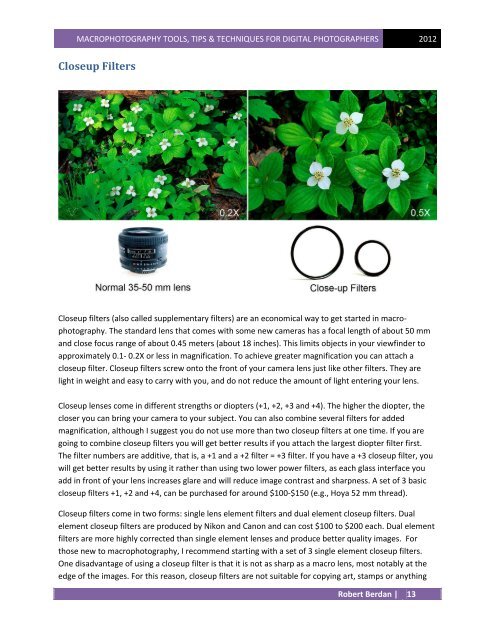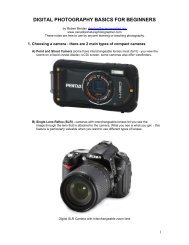Download PDF - The Canadian Nature Photographer
Download PDF - The Canadian Nature Photographer
Download PDF - The Canadian Nature Photographer
Create successful ePaper yourself
Turn your PDF publications into a flip-book with our unique Google optimized e-Paper software.
MACROPHOTOGRAPHY TOOLS, TIPS & TECHNIQUES FOR DIGITAL PHOTOGRAPHERS 2012<br />
Closeup Filters<br />
Closeup filters (also called supplementary filters) are an economical way to get started in macrophotography.<br />
<strong>The</strong> standard lens that comes with some new cameras has a focal length of about 50 mm<br />
and close focus range of about 0.45 meters (about 18 inches). This limits objects in your viewfinder to<br />
approximately 0.1- 0.2X or less in magnification. To achieve greater magnification you can attach a<br />
closeup filter. Closeup filters screw onto the front of your camera lens just like other filters. <strong>The</strong>y are<br />
light in weight and easy to carry with you, and do not reduce the amount of light entering your lens.<br />
Closeup lenses come in different strengths or diopters (+1, +2, +3 and +4). <strong>The</strong> higher the diopter, the<br />
closer you can bring your camera to your subject. You can also combine several filters for added<br />
magnification, although I suggest you do not use more than two closeup filters at one time. If you are<br />
going to combine closeup filters you will get better results if you attach the largest diopter filter first.<br />
<strong>The</strong> filter numbers are additive, that is, a +1 and a +2 filter = +3 filter. If you have a +3 closeup filter, you<br />
will get better results by using it rather than using two lower power filters, as each glass interface you<br />
add in front of your lens increases glare and will reduce image contrast and sharpness. A set of 3 basic<br />
closeup filters +1, +2 and +4, can be purchased for around $100-$150 (e.g., Hoya 52 mm thread).<br />
Closeup filters come in two forms: single lens element filters and dual element closeup filters. Dual<br />
element closeup filters are produced by Nikon and Canon and can cost $100 to $200 each. Dual element<br />
filters are more highly corrected than single element lenses and produce better quality images. For<br />
those new to macrophotography, I recommend starting with a set of 3 single element closeup filters.<br />
One disadvantage of using a closeup filter is that it is not as sharp as a macro lens, most notably at the<br />
edge of the images. For this reason, closeup filters are not suitable for copying art, stamps or anything<br />
Robert Berdan | 13




